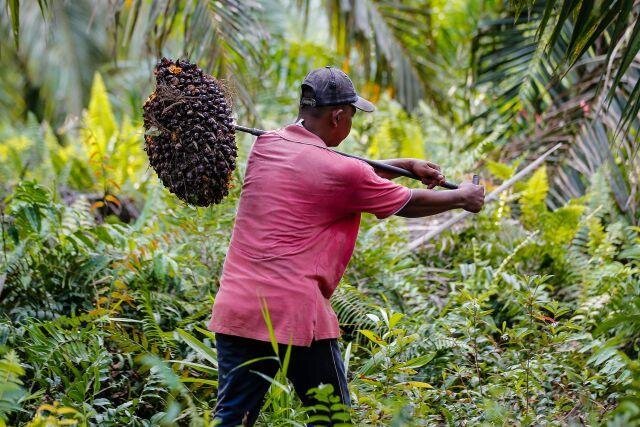The Hidden Costs of Palm Oil
An Indonesian farmer harvesting an oil palm bunch. (World Resources Institute)
By Payton-luv Stine
Whether you know it or not, you probably used palm oil today. This highly lucrative product is used globally, not only by highly developed nations in packaged products, food production, cosmetic supplies, and biodiesel, but also in developing nations as a cooking oil. Nearly every aspect of our lives has a stake in the future of the palm oil industry. The product is cheap, easy to manufacture, easy to store, and lasts a long time.
When compared to other products, such as rice it is nearly 10x more profitable, bringing in $2,500 per hectare while rice plantations bring in only $250. In Indonesia alone, an estimated 25 million individuals have palm oil production to thank for their livelihoods, with palm oil making up over 12 percent of the country’s annual exports. There is no doubt that the palm oil plantation truly has reduced poverty in local Indonesian communities and allowed for the construction of newer and better developed infrastructure, both directly and indirectly. The industry also does not exclude small land owners, with over 40 percent of plantations owned by individual land holders rather than large corporations.
Indonesia is not the only nation to reap the benefits of this product. Malaysia exports nearly 17 tons of palm oil annually, at a value of around $15 billion U.S. dollars. That’s over 9 percent of the country’s exports, and nearly 3 percent of the nation’s GDP. Nearly one million Malaysians are employed by palm oil plantations allowing them to provide for their families and themselves reducing the widespread financial insecurity in the region. However, this number does not include the undocumented and contract workers that are estimated to amount to over 4 million in Malaysia alone.
Palm oil is a great resource and makes lives better every day, but we have yet to master responsible consumption and production of this product, the 12th Sustainable Development Goal. Its true cost cannot be broken down into dollars and cents, but instead is represented in lives. What isn’t considered is the lives besides our the “winners” that have stake in this industry as well.
Indonesian forest fires also cause smoke and air pollution, responsible for nearly 40,000 human deaths a year in the surrounding region. The haze directly linked to “slash-and-burn” by palm oil companies causes more than 200,000 respiratory infections annually. Smoke from these forest fires does not just have negative impacts on the health of the region. It has also resulted in over 1,500 Malaysian schools and education centers closing their doors, and countless days of class cancelled due to threatening air quality. The education and opportunities lost from this is immense, especially when considering the highly volatile state of Malaysia as an emerging economy. On a more global scale, tropical deforestation accounts for 10% of the world’s global greenhouse gas emissions. Last year palm oil companies’ “slash and burn” harvesting techniques jeopardized the lives of 10,000 orangutans, and over the past fifty years has killed over 100,000. This doesn’t even include other species like the cloud leopard, hornbills and the Borneo elephants affected by these hotspot fires.
This kind of disregard for life by palm oil companies is unacceptable. Still we cannot forget the vast array of benefits palm oil brings to the lives of not millions but billions of individuals around the world, holding the power to revolutionize our world once more. The true question is where do we draw the line? At what point is the economic success of a developing nation not worth the environmental impact?
If destroying our planet’s biodiversity, ruining our children’s education and jeopardizing our family’s health is not enough to beg the question “Is it worth it?,” then what is? Economic success will be the least of our worries when our mothers and fathers cannot breathe, our children cannot read, and our world cannot survive. No dollar amount is worth any life.. Prosperity at the expense of our world is an oxymoron. Without that understanding, we will never be able to truly grow.

